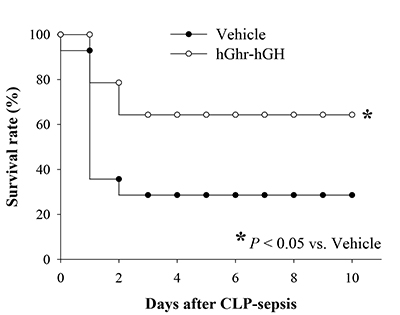Sepsis is a systemic inflammatory response secondary to infection which eventually progresses to multiple organ dysfunction (severe sepsis) and intractable hypotension (septic shock). Sepsis affects more than one million Americans annually, and accounts for 20% of all admission to intensive care units. Furthermore, with an overall mortality rate of 30%, sepsis accounts for more than 50% of all hospital deaths.
The incidence of severe sepsis and septic shock is particularly high among the elderly, and nearly 80% of septic deaths occur in patients older than 65 years of age. Over the past several decades, thousands of patients have been enrolled in sepsis clinical trials with little success. One of the reasons for the failure is that the preclinical evaluation of nearly all anti-sepsis candidate drugs is conducted on the young instead of the aged animals. Like animals, growth hormone levels in human decline at a rate of approximately 15% per decade after age 25, which is associated with many symptoms of aging including wrinkles, grey hair, hair loss, cardiovascular disease, and osteoporosis. By studying aged animals, TheraSource has demonstrated that co-administration of human ghrelin and growth hormone reduces the severity and mortality of septic aged animals.
Read more about ghrelin plus growth hormone.
Preclinical studies:

Human ghrelin plus growth hormone combination therapy improves survival in experimental sepsis. Treatment with combination therapy significantly improved the 10-day survival rate of aged rats after cecal ligation and puncture (CLP), a well-established experimental model of sepsis, from 28% to 64%. Vehicle (normal saline) or combination therapy (80 nmol/kg human ghrelin plus 50 µg/kg human growth hormone per kg of body weight) was administered a single subcutaneous injection at 5 hours after CLP. Survival rates were estimated using the Kaplan-Meier method (n=14/group), and compared using the log-rank test; *P < 0.05 vs. vehicle.
